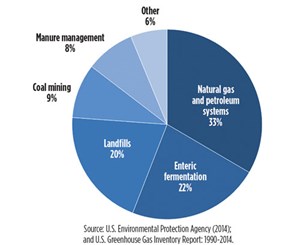Energy issues
In April, I filled this column with a discussion of methane emissions, and the hypocrisy of politicians and the public for blaming most of those emissions on the oil and gas industry, even though evidence did not substantiate that conclusion. Subsequent analyses by respected organizations, including the National Oceanic Atmospheric Administration (NOAA, a U.S. federal government institution) and the GHG Management Institute, have confirmed that the primary culprit is not the oil and gas industry. These findings have fallen, mostly, on deaf ears.
Study findings. Published in the journal Nature during early November, NOAA’s research findings were based on the largest database of global methane emissions yet compiled. The data produced the clearest image, thus far, of the number of methane molecules in the atmosphere and their likely release points. With this information, NOAA concluded that methane emissions from fossil fuels were significantly underestimated, but that the overall increases in atmospheric methane were not due to fossil fuels, and particularly not to oil and gas.
As reported in State Impact, a reporting project of National Public Radio reporting stations, lead author of the NOAA paper Stefan Schwietzke, a scientist with the Cooperative Institute for Research in Environmental Sciences (CIRES) at the University of Colorado–Boulder, said “that while natural gas production has increased, the rate of methane leakage, or the amount of natural gas that escapes or is vented as measured against the amount that is captured and sent through a pipeline to market, has actually decreased from 8% to 2% in the last 30 years. What we found is that the absolute amount of emissions has remained constant, while production of fossil fuels has increased dramatically,” said Schwietzke.
Research at Carnegie Mellon University concurs with the 2% figure, according to Professor Albert Presto, who was not involved in the NOAA study but was the lead investigator for the Carnegie Mellon study. While this figure is significantly lower than many thought, in relation of total methane emissions, there is still room for improvement. As Lori Bruhwiler, a NOAA research scientist and co-author of the NOAA study, noted in the State Impact report, “our study shows that leaks from oil and gas activities around the world are responsible for a lot more methane than we thought. The good news is that fixing leaking oil and gas infrastructure is a very effective, short-term way to reduce emissions of this important greenhouse gas.”
EPA doesn’t listen. Unfortunately, the U.S. Environmental Protection Agency (EPA, another Federal institution) is not buying this explanation. That is the opinion of Jeff Stier, senior fellow at the National Center for Public Policy Research in Washington, D.C., and head of its Risk Analysis Division. In his Nov. 8 blog on www.thehill.com/blogs/congress-blogs/economy-budget, Stier noted that, last year, “the EPA reported that, since 2005, net methane emissions from natural gas infrastructure had fallen 38%, while total methane emissions from natural gas had dropped 11%. This year, however, the EPA claims methane emissions from the oil and gas industry are one-third higher than previously thought. And, it says that overall methane emissions from natural gas have dropped only 0.68% since 2005.” These disparate figures, says Stier, are predicated on a new, highly suspect methane methodology that is based on sources developed in the 1990s, with much of the new data “extrapolated from some of the largest methane emitters, which inflates the current measurements.”
The result is a new set of regulations on methane emissions for the industry, promulgated as part of the Obama administration’s goal to cut methane emissions from oil and gas operations by up to 45% by 2025. The tighter limits, according to the EPA, will cost $530 million by 2025. According to Stier, however, “other studies have found that the annual price tag to comply with these regulations could hit $800 million. National Economic Research Associates has concluded that, by 2020, the regulations could be three times more expensive than the EPS projects.”
How does the industry deal with this situation? First, Stier notes, the industry has been very successful at reducing carbon dioxide emissions, investing some $90 billion on zero and low-carbon technologies since 2000. Methane emissions should be easier to rein in than carbon dioxide emissions, but that doesn’t mean it is going to be cheap, or easy.
Segments of the industry are pushing back on methane emission limits. “Imposing a one-size-fits-all scheme on the industry could actually stifle innovation and discourage investments in new technologies that could further serve to reduce emissions,” said API V.P. Kyle Isakower. That certainly could be true, but it will probably fall on deaf ears also. ![]()

- Applying ultra-deep LWD resistivity technology successfully in a SAGD operation (May 2019)
- Adoption of wireless intelligent completions advances (May 2019)
- Majors double down as takeaway crunch eases (April 2019)
- What’s new in well logging and formation evaluation (April 2019)
- Qualification of a 20,000-psi subsea BOP: A collaborative approach (February 2019)
- ConocoPhillips’ Greg Leveille sees rapid trajectory of technical advancement continuing (February 2019)



